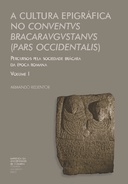Explore

A Cultura Epigráfica no Conventus Bracaraugustanus (Pars Occidentalis)
Armando Redentor
2017
0 Ungluers have
Faved this Work
Login to Fave
The Roman occupation of the Iberian northwest led to the emergence of the epigraphic habit, a new practice of cultural communication introduced by the imperial administration and its agents. Local peoples rapidly adopted this trend, which was disseminated through its social elites. As a form of communication, epigraphs were mainly used for both individual and communal celebrations and self-representations. The material that is evidence of this practice, the engraved surfaces with writings on a variety of topics, are today privileged sources that enable us to address the challenges posed by the study of the societies of classical antiquity, despite the fact that they can provide only a fragmentary picture of the world from which they arise. These are the main concerns of this research, which focuses on southern Callaecia. From a starting point of the review of the epigraphic data originating from western Bracarensis, an attempt has been made to clarify its nature, chronology and representativeness, investigating some of the markers of the society that gave life to the territory, settlements and roads they were connected by during Roman rule.
This book is included in DOAB.
Why read this book? Have your say.
You must be logged in to comment.
Rights Information
Are you the author or publisher of this work? If so, you can claim it as yours by registering as an Unglue.it rights holder.Downloads
This work has been downloaded 176 times via unglue.it ebook links.
- 176 - pdf (CC BY-NC-ND) at Unglue.it.
Keywords
- Epigraphy
- Portuguese
- Regional & area planning
- roman period
- Society
- Transport planning & policy
- western conventvs Bracaraugustanus
Links
DOI: 10.14195/978-989-26-1270-6Editions

